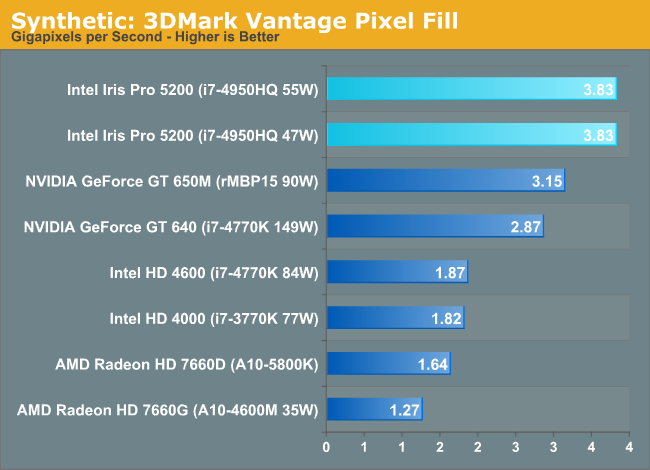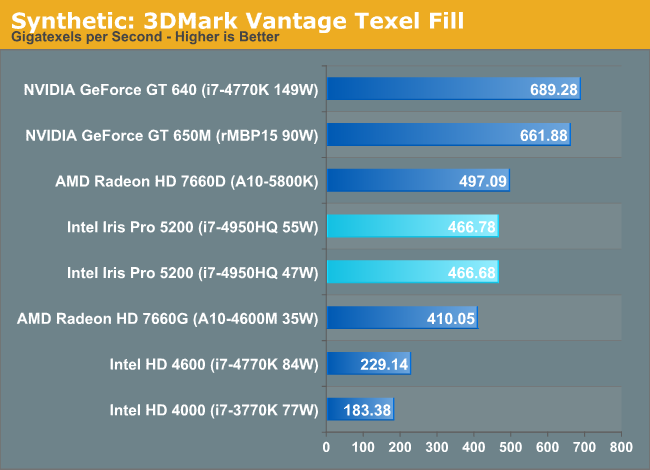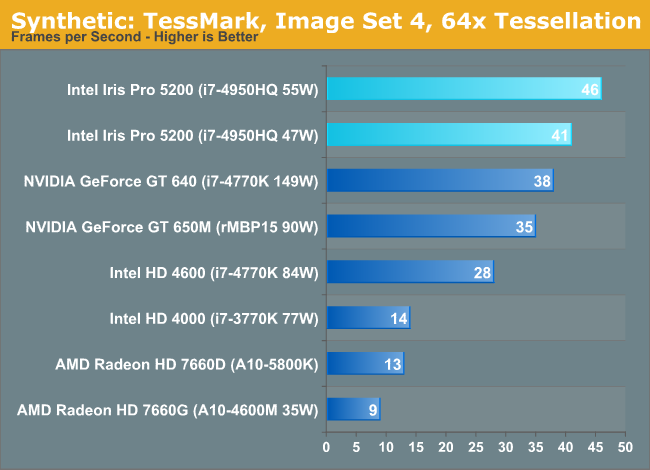Intel Iris Pro 5200 Graphics Review: Core i7-4950HQ Tested
by Anand Lal Shimpi on June 1, 2013 10:01 AM ESTSynthetics
Our synthetic benchmarks can sometimes tell us a lot about what an architecture is capable of. In this case, we do have some unanswered questions about why Intel falls short of the GT 650M in some cases but not in others. We'll turn to 3DMark Vantage first to stress ROP and texel rates.

Iris Pro doesn't appear to have a ROP problem, at least not in 3DMark Vantage. NVIDIA can output more pixels than Iris Pro though, so it's entirely possible that we're just not seeing any problems because we're looking at a synthetic test. Comparing the HD 4600 to the Iris Pro 5200 we see near perfect scaling in pixel throughput. Remember the ROP hardware is located in slice common, which is doubled when going from GT2 to GT3. Here we see a near doubling of pixel fillrate as a result.
Moving on, we have our 3DMark Vantage texture fillrate test, which does for texels and texture mapping units what the previous test does for ROPs.

Now this is quite interesting. NVIDIA has a 50% advantage in texturing performance, that's actually higher than what the raw numbers would indicate. It's entirely possible that this is part of what we're seeing manifest itself in some of the game benchmarks.
Finally we’ll take a quick look at tessellation performance with TessMark.

Iris Pro doesn't appear to have a geometry problem. Tessellation performance is very good.










177 Comments
View All Comments
Old_Fogie_Late_Bloomer - Monday, June 3, 2013 - link
The performance isn't earth-shattering, but if Intel manages to put out good open-source Linux drivers for Iris Pro, I can't help but feel like this would be a great chip for that; it isn't like you'll be playing Crysis in Ubuntu anytime soon. I kind of want that CRB (or something like it), actually.tviceman - Saturday, June 1, 2013 - link
I'll bet notebooks with mid-range quad core CPU's and gt 750m discrete graphics will be cheaper than notebooks with Iris Pro enabled iGPU graphics as well. The only benefit would be a slightly slimmer chassis and battery life. Anyone who still wants to game on a notebook is noticeably better off with a mid-range discrete GPU over this.esterhasz - Saturday, June 1, 2013 - link
On page four, the ominous launch partner is not "keen" rather than "key", I guess. I'd be very keen on having that rMBP 13" with IP5200, though.Ryan Smith - Saturday, June 1, 2013 - link
Noted and fixed. Thank you.tipoo - Saturday, June 1, 2013 - link
I'm very much in that boat too, a quad core 13" rMBP with Iris Pro would put it over the top.MattVincent - Wednesday, June 12, 2013 - link
totally agree. I wonder if apple will actually put a quad core in the 13" though. I bet they would rather sell more 15" rmbp'sjeffkibuule - Saturday, June 1, 2013 - link
Would a 47W chip be able to fit into a normal 13" Ultrabook-like chassis like the 13" MacBook Pro with Retina Display? Only an extra 12W TDP to deal with.esterhasz - Saturday, June 1, 2013 - link
This would be awesome and we have to remember that the 47W TDP includes voltage regulation moving off the MB, so the gap is maybe only 8W. The 47 TDP also refers to both CPU and GPU running at full speed, which is an extremely rare scenario - in gaming, the CPU load will probably hover at 50% only.In any case, if the tested model goes into a rMBP 13" I'm going to buy it before Tim Cook has left the stage.
nofumble62 - Saturday, June 1, 2013 - link
Thinking to buy a Ivybridge Mac Book Pro for my wife, I guess she will have wait a little longer for this baby. I wish they could fit in a Mac Book Air.jeffkibuule - Saturday, June 1, 2013 - link
Look at the price of those chips though, you're going to be dropping at least $2000 on such a laptop when the CPU alone is $478.